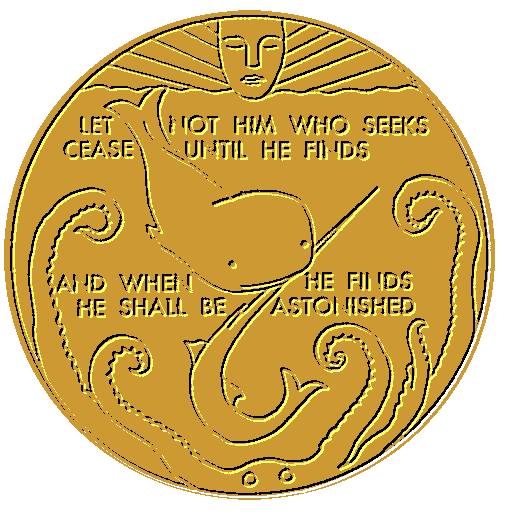

"As a device for the jacket of Explorations he sent his
editors a copy of the bronze medallion that had been cast
for distribution to all Clinic Ph.D.s at the tenth
anniversary celebration in 1937. Designed primarily by
Christiana and subsequently adopted as the Clinic's "coat of
arms," the medallion represents the unconscious as a vast
undersea world of mighty creatures. Just above the water,
as if afloat upon it, a human face reposes in sunlight.
Harry once explained that the octopus at the bottom of the
sea symbolizes the possessive, cosmic mother; a whale near
the surface is leviathan, the devouring father; in the
middle is a swordfish, representing youth, which strains
upward, against the parents, and toward the light of
consciousness above. It is an allegory of Jungian
individuation, the process of emergence into wholeness which
first inspired the dyad and to which it was dedicated.
Across the scene appear words that Harry ascribed, somewhat
vaguely, to Jung--'Let Not Him Who Seeks Cease Until
He Finds, And When He Finds He Shall Be Astonished.'"
(Robinson, 1992, p. 231).
In addition to being used on the dust jacket of
Explorations in Personality, the design also appeared
on the title page of Endeavors in Psychology and on
the 1988 announcement for a memorial service celebrating the
life of Henry A. Murray.
Alan Elms located the source of the quotation in a saying of Jesus in the apocryphal
Gospel of Thomas. Elms said that Murray told him that, "…Christiana had come up
with the quotation while they were putting together a list of possible quotations
for the medallion, and they agreed on that one." (A. Elms, personal communication,
August 22, 2000)
Most recent translations of the Gospel of Thomas come from Coptic texts
found at Nag Hammadi, Egypt in 1945. Because the medallion was designed in 1937,
these Coptic manuscripts could not have been the source of the medallion's text.
However, fragments of the Gospel of Thomas were known from Greek papyri found in
1897 and 1903 near the town of Oxyrhynchus, an ancient city about 125 miles south of
Cairo, and it is from one of these that the quotation likely originated. Papyrus
Oxyrhynchus 654.5-9 is translated as follows: "Jesus saith, Let not him who
seeks…cease until he finds, and when he finds he shall be astonished; astonished he
shall reach the kingdom, and having reached the kingdom he shall rest." (Grenfell &
Hunt, 1904, part IV, p. 4) It should be noted that the translation above exactly
matches the text on the medallion. Translations offered by others seem only seem to
approximate it using, for example, "disturbed," "troubled," "wonder," etc, instead
of "astonished."
Thanks is extended to Moe Stein (1996) for showing me his plaster cast
replica of the medallion.
Grenfell, B. P., & Hunt, A. S. (1904). The Oxyrhynchus papyri: Part IV. London: Egypt Exploration Fund.
Murray, H. A. (1938). Explorations in personality: A clinical and experimental study of fifty men of college age. New York: Oxford University Press.
Robinson, F. G. (1992). Love's story told: A life of Henry A. Murray. Cambridge, MA: Harvard University Press.
Shneidman, E. S. (Ed.). (1981). Endeavors in psychology: Selections from the personology of Henry A. Murray. New York: Harper & Row.
Stein, M. I. (1996, August 12). Discussant at a symposium, "What's the story? A 60th anniversary celebration of the TAT." 104th Annual Meeting of the American Psychological Association, Toronto, ONT, Canada.

| 
|
Last revised: 7 September 2000